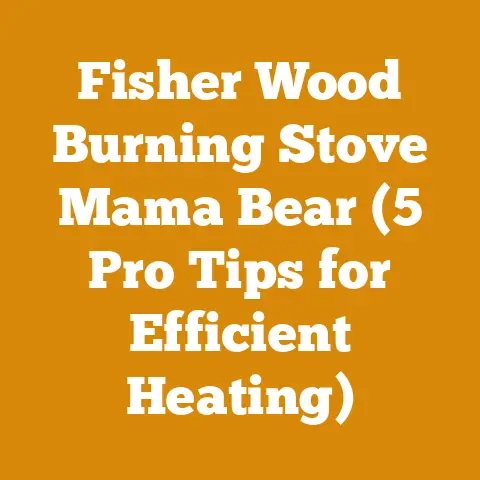Pellet Wood Combo Stove Use (Dual-Fuel Heating Tips & Tricks)
Have you ever felt that bone-chilling cold seep into your home, despite the thermostat stubbornly clinging to a respectable number? I have. It’s a feeling that drove me to explore every heating option imaginable, ultimately leading me to the fascinating world of pellet wood combo stoves. It’s not just about warmth; it’s about smart, efficient, and versatile heating. Let me share what I’ve learned about maximizing the potential of these dual-fuel marvels.
Pellet Wood Combo Stove Use (Dual-Fuel Heating Tips & Tricks)
A pellet wood combo stove offers the best of both worlds: the consistent, automated heating of pellet fuel and the rustic charm and raw power of burning wood. But mastering its use requires understanding the nuances of both fuel types and the stove’s operation.
Understanding Your Combo Stove
Before diving into specific techniques, let’s ensure you know the basics. A combo stove isn’t just two stoves crammed into one. It’s a carefully engineered appliance designed to burn either wood or wood pellets, often with sophisticated controls to manage airflow and fuel feed.
- The Hopper: This holds the wood pellets. Pay attention to its capacity – it dictates how often you’ll need to refill it.
- The Burn Pot: This is where the pellets are burned. Regular cleaning is crucial to maintain efficient combustion.
- The Firebox: This is where you burn wood. Its size will dictate the maximum log size you can use.
- The Air Controls: These regulate airflow, essential for clean and efficient burning of both fuel types.
- The Exhaust System: Proper venting is paramount for safety and performance. Ensure it’s clean and free of obstructions.
Fueling the Fire: Wood vs. Pellets
The heart of a combo stove’s versatility lies in its ability to burn two distinct fuels. Understanding their differences is key to optimal performance.
Wood: The Traditional Choice
Wood offers a raw, renewable heating source. But not all wood is created equal.
- Hardwoods vs. Softwoods: Hardwoods like oak, maple, and ash provide denser, longer-burning fuel. Softwoods like pine and fir ignite easily but burn faster. For sustained heat, hardwoods are generally preferable.
- Moisture Content is King: Seasoned wood, with a moisture content of 20% or less, burns cleaner and more efficiently. Use a moisture meter to check your wood. I aim for 15-18% for my stove.
- Wood Size Matters: Follow your stove manufacturer’s recommendations for log size. Overloading the firebox can lead to incomplete combustion and dangerous creosote buildup.
Pellets: The Modern Alternative
Wood pellets are compressed sawdust, offering a consistent and convenient fuel source.
- Pellet Quality: Look for premium-grade pellets with low ash content. This reduces the frequency of cleaning and minimizes stove maintenance.
- Storage: Store pellets in a dry place to prevent them from absorbing moisture. Damp pellets burn poorly and can clog the auger.
- Pellet Types: Hardwood and softwood pellets are available. Hardwood pellets generally provide more heat per pound, but softwood pellets may ignite more easily.
Mastering the Art of Wood Burning in Your Combo Stove
Burning wood in a combo stove isn’t quite the same as in a traditional wood stove. These tips will help you maximize efficiency and safety.
Building the Perfect Fire
- The Top-Down Method: I’ve found that the top-down fire building method works exceptionally well in combo stoves. Start with a layer of larger logs, then add smaller kindling on top, and finally, a small amount of tinder. This allows the fire to burn downwards, producing cleaner and more efficient combustion.
- Airflow is Key: Open the air controls fully when starting the fire. Once the fire is established, gradually reduce the airflow to maintain a steady burn.
- Don’t Overload: Avoid stuffing the firebox full of wood. Leave space for air to circulate around the logs.
Maintaining a Clean Burn
- Burn Hot: A hot fire burns cleaner and reduces creosote buildup. Avoid smoldering fires.
- Regular Inspections: Inspect your chimney regularly for creosote buildup. Have it professionally cleaned if necessary.
- Use a Chimney Thermometer: Monitor flue temperatures to ensure efficient and safe burning.
Pellet Power: Optimizing Pellet Burning in Your Combo Stove
Pellet burning offers convenience and consistent heat. Here’s how to get the most out of it.
Understanding Your Stove’s Pellet Settings
- Feed Rate: This controls the amount of pellets fed into the burn pot. Adjust this setting to achieve your desired heat output.
- Airflow: Adjust the airflow to match the feed rate. Too much air can extinguish the flame, while too little air can lead to incomplete combustion.
- Thermostat Control: Most combo stoves offer thermostat control for pellet burning. Experiment with different settings to find the most comfortable and efficient temperature.
Maintaining Pellet Stove Efficiency
- Regular Cleaning: Clean the burn pot and ash pan regularly. Ash buildup can impede airflow and reduce efficiency.
- Auger Maintenance: Ensure the auger (the mechanism that feeds pellets into the burn pot) is clean and free of obstructions.
- Hopper Management: Don’t let the hopper run completely empty. This can cause the auger to lose prime, making it difficult to restart the stove.
Dual-Fuel Strategies: When to Burn Wood vs. Pellets
The real beauty of a combo stove lies in its flexibility. Here are some strategies for choosing between wood and pellets.
The Shoulder Season Shuffle
- Pellets for Convenience: During the shoulder seasons (spring and fall), when heating needs are less intense, pellets offer a convenient and low-maintenance option.
- Wood for a Weekend Boost: On chilly weekends, fire up the wood for a cozy and rustic ambiance.
Emergency Heating Preparedness
- Backup Fuel: Keep a supply of both wood and pellets on hand for emergency heating situations. This ensures you’ll have a heat source regardless of power outages or fuel shortages.
- Wood for Power Outages: In a power outage, you can still burn wood in your combo stove, providing essential heat and potentially the ability to cook.
Cost Optimization
- Compare Fuel Costs: Regularly compare the cost per BTU (British Thermal Unit) of wood and pellets in your area. Choose the more economical fuel source based on current prices.
- Bulk Buying: Purchase wood and pellets in bulk during the off-season to take advantage of lower prices.
Safety First: Essential Precautions for Combo Stove Operation
Safety is paramount when operating any heating appliance. These precautions will help you stay safe and avoid potential hazards.
Carbon Monoxide Detection
- Install CO Detectors: Install carbon monoxide detectors on every level of your home, especially near sleeping areas.
- Test Regularly: Test your CO detectors regularly to ensure they are functioning properly.
- Know the Symptoms: Be aware of the symptoms of carbon monoxide poisoning, such as headache, dizziness, nausea, and confusion.
Chimney Safety
- Professional Inspections: Have your chimney professionally inspected and cleaned at least once a year.
- Proper Venting: Ensure your stove is properly vented according to manufacturer’s instructions.
- Creosote Awareness: Be aware of the dangers of creosote buildup and take steps to minimize it.
General Safety Practices
- Keep Clearances: Maintain proper clearances between the stove and combustible materials, as specified in the owner’s manual.
- Protect Children and Pets: Keep children and pets away from the hot stove.
- Never Use Flammable Liquids: Never use flammable liquids to start a fire in your stove.
Troubleshooting Common Combo Stove Problems
Even with proper care and maintenance, combo stoves can sometimes experience problems. Here are some common issues and how to address them.
Pellet Stove Problems
- Stove Won’t Start: Check the hopper for pellets, ensure the auger is not jammed, and verify that the igniter is working.
- Weak Flame: Clean the burn pot, adjust the airflow, and ensure you are using high-quality pellets.
- Excessive Ash Buildup: Use premium-grade pellets with low ash content and clean the stove regularly.
- Auger Jamming: Remove any foreign objects from the hopper and ensure the auger is properly lubricated.
Wood Stove Problems
- Difficult to Start Fire: Use dry, seasoned wood and ensure adequate airflow.
- Smoky Fire: Check the chimney for obstructions and ensure the wood is properly seasoned.
- Creosote Buildup: Burn hot fires and have your chimney professionally cleaned regularly.
- Backdrafting: Ensure your home has adequate ventilation and that the chimney is properly sized for the stove.
Advanced Techniques: Fine-Tuning Your Combo Stove Performance
Once you’ve mastered the basics, you can start experimenting with advanced techniques to further optimize your combo stove’s performance.
Combustion Tuning
- Adjusting Airflow for Wood: Experiment with different airflow settings to find the sweet spot for your wood type and fire size. Too much air will cool the fire, while too little air will lead to incomplete combustion.
- Pellet Feed Rate Optimization: Fine-tune the pellet feed rate to match your heating needs and maximize efficiency.
Heat Distribution Strategies
- Circulation Fans: Use fans to circulate warm air throughout your home.
- Zone Heating: Focus heating on the rooms you use most often.
- Stove Placement: Position your stove in a central location to maximize heat distribution.
Monitoring and Data Logging
- Track Fuel Consumption: Keep track of your wood and pellet consumption to monitor efficiency and identify potential problems.
- Flue Temperature Monitoring: Use a flue thermometer to monitor flue temperatures and ensure safe and efficient burning.
- Ambient Temperature Logging: Track ambient temperatures in your home to optimize heating settings.
The Future of Combo Stoves: Innovations and Trends
The world of combo stoves is constantly evolving. Here are some emerging trends and innovations to watch for.
Smart Stove Technology
- Remote Monitoring and Control: Some new stoves offer remote monitoring and control via smartphone apps.
- Automated Fuel Switching: Stoves that automatically switch between wood and pellets based on user preferences.
- Smart Thermostat Integration: Integration with smart thermostats for enhanced temperature control.
Improved Efficiency and Emissions
- Advanced Combustion Systems: New combustion technologies that improve efficiency and reduce emissions.
- Catalytic Combustors: Catalytic combustors that further reduce emissions.
- EPA Certification: Look for stoves that are EPA-certified for low emissions.
Sustainable Fuel Sources
- Biomass Pellets: Pellets made from sustainable biomass sources like agricultural waste.
- Alternative Wood Sources: Utilizing wood from sustainable forestry practices.
- Fuel Blending: Experimenting with blends of different fuel types to optimize performance.
Case Studies: Real-World Examples of Combo Stove Success
Let’s look at some real-world examples of how people are successfully using combo stoves to heat their homes.
Case Study 1: Off-Grid Living in Vermont
- The Challenge: A family living off-grid in Vermont needed a reliable and versatile heating source.
- The Solution: They installed a combo stove and used wood as their primary fuel source, supplemented by pellets during periods of extreme cold or when they were away from home.
- The Results: They significantly reduced their reliance on propane and achieved a comfortable and sustainable heating solution.
Case Study 2: Supplemental Heating in Colorado
- The Challenge: A homeowner in Colorado wanted to supplement their existing propane furnace with a more cost-effective heating option.
- The Solution: They installed a combo stove and used pellets as their primary fuel source, switching to wood for occasional ambiance and supplemental heat.
- The Results: They reduced their propane consumption by 50% and saved money on their heating bills.
Case Study 3: Emergency Preparedness in Oregon
- The Challenge: A family in Oregon wanted to be prepared for potential power outages and fuel shortages.
- The Solution: They installed a combo stove and stocked up on both wood and pellets.
- The Results: During a severe winter storm that knocked out power for several days, they were able to stay warm and comfortable thanks to their combo stove.
Maintaining Your Investment: Essential Maintenance Tips
A combo stove is an investment, and like any investment, it requires regular maintenance to ensure optimal performance and longevity.
Daily/Weekly Maintenance
- Empty the Ash Pan: Empty the ash pan regularly to prevent ash buildup.
- Clean the Burn Pot: Clean the burn pot to ensure proper airflow.
- Inspect the Firebox: Inspect the firebox for any signs of damage or creosote buildup.
Monthly Maintenance
- Clean the Heat Exchanger: Clean the heat exchanger to maintain efficiency.
- Lubricate Moving Parts: Lubricate any moving parts, such as the auger motor.
- Inspect the Gaskets: Inspect the door and window gaskets for leaks.
Annual Maintenance
- Professional Inspection: Have your stove professionally inspected and cleaned by a qualified technician.
- Chimney Cleaning: Have your chimney professionally cleaned to remove creosote buildup.
- Replace Worn Parts: Replace any worn or damaged parts, such as the igniter or blower motor.
Choosing the Right Combo Stove for Your Needs
With so many combo stoves on the market, choosing the right one can be a daunting task. Here are some factors to consider.
Heating Capacity
- Square Footage: Determine the square footage you need to heat.
- Climate: Consider the climate in your area.
- Insulation: Factor in the insulation levels in your home.
Fuel Availability and Cost
- Wood Availability: Assess the availability and cost of wood in your area.
- Pellet Availability: Determine the availability and cost of pellets in your area.
- Fuel Storage: Consider your fuel storage options.
Features and Options
- Hopper Size: Choose a hopper size that meets your needs.
- Thermostat Control: Consider whether you want thermostat control.
- Automatic Ignition: Look for stoves with automatic ignition.
Budget
- Initial Cost: Determine your budget for the stove itself.
- Installation Costs: Factor in installation costs.
- Operating Costs: Consider ongoing fuel and maintenance costs.
DIY vs. Professional Installation: Making the Right Choice
Installing a combo stove can be a complex and potentially dangerous task. Here’s how to decide whether to DIY or hire a professional.
DIY Installation
- Pros: Save money on installation costs.
- Cons: Requires technical skills and knowledge, can be dangerous if not done properly, may void the warranty.
Professional Installation
- Pros: Ensures proper and safe installation, protects the warranty, provides peace of mind.
- Cons: Can be expensive.
Factors to Consider
- Your Skill Level: Assess your technical skills and experience.
- Local Regulations: Check local building codes and regulations.
- Warranty Requirements: Review the manufacturer’s warranty requirements.
The Environmental Impact of Combo Stoves
Burning wood and pellets can have an environmental impact. Here’s what you need to know.
Emissions
- Particulate Matter: Wood and pellet stoves can emit particulate matter, which can contribute to air pollution.
- Carbon Monoxide: Incomplete combustion can produce carbon monoxide, a dangerous gas.
- Greenhouse Gases: Burning wood releases carbon dioxide, a greenhouse gas.
Sustainability
- Renewable Resource: Wood is a renewable resource if harvested sustainably.
- Carbon Neutrality: Wood burning can be carbon neutral if the wood is harvested from sustainably managed forests.
- Pellet Production: Pellet production can have an environmental impact, depending on the source of the wood and the manufacturing process.
Mitigation Strategies
- Burn Clean: Burn hot fires with dry, seasoned wood or high-quality pellets.
- Maintain Your Stove: Regularly maintain your stove to ensure efficient combustion.
- Use EPA-Certified Stoves: Choose EPA-certified stoves for low emissions.
Financial Incentives and Rebates
Many governments and utilities offer financial incentives and rebates for purchasing and installing high-efficiency wood and pellet stoves.
Federal Tax Credits
- Renewable Energy Tax Credit: Check for federal tax credits for renewable energy purchases.
State and Local Rebates
- State Energy Programs: Explore state energy programs that offer rebates for efficient heating appliances.
- Utility Rebates: Inquire about rebates offered by your local utility company.
Eligibility Requirements
- EPA Certification: Ensure the stove meets EPA certification requirements.
- Efficiency Standards: Check for minimum efficiency standards.
- Installation Requirements: Verify that the installation meets local building codes.
Resources for Further Learning
Here are some resources for further learning about combo stoves and wood heating.
Government Agencies
- Environmental Protection Agency (EPA): The EPA website provides information on wood stove regulations and emissions standards.
- Department of Energy (DOE): The DOE website offers resources on energy efficiency and renewable energy.
Industry Associations
- Hearth, Patio & Barbecue Association (HPBA): The HPBA is a trade association for the hearth industry.
- Pellet Fuels Institute (PFI): The PFI is a trade association for the pellet fuel industry.
Online Forums and Communities
- Wood Heat Forums: Online forums where you can connect with other wood stove users and ask questions.
- Pellet Stove Forums: Online forums dedicated to pellet stove discussions.
Conclusion: Embracing the Versatility of Combo Stoves
Combo stoves offer a unique blend of traditional warmth and modern convenience. By understanding the nuances of wood and pellet burning, mastering the stove’s controls, and prioritizing safety and maintenance, you can unlock the full potential of this versatile heating appliance. Whether you’re seeking a sustainable heating solution, a cost-effective way to supplement your existing system, or a reliable backup for emergency situations, a combo stove can be a valuable addition to your home. So, go ahead, embrace the dual-fuel advantage and experience the warmth and comfort that a combo stove can provide. I hope my experience has given you the knowledge to start your own journey.






